Teach your dog to play a (controlled) game of Tug-of-War
By Michele Welton, Dog Trainer, Breed Selection Consultant, Author of 15 Dog Books
In Tug-of-War, you hold onto one end of a toy while your dog holds onto the other end and tries to pull it away from you.
Tug is a controversial game.
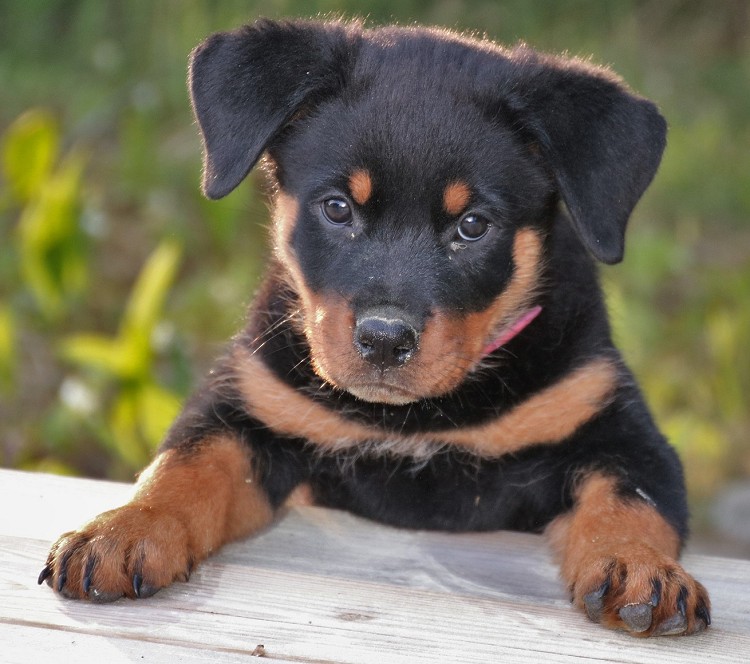
Many breeds, like this Rottweiler pup, are very enthusiastic about playing Tug. But to avoid behavior problems, be sure to play it properly.
On the plus side....
- Tug is a convenient way to provide an active dog with a quick physical workout. Exercise keeps your dog's body trim and fit and gives him an outlet for relieving stress and tension.
- Tug gives your dog the opportunity to use his natural instincts to mouth and chew and bite, without hurting anyone or destroying things. He can bite down on the Tug toy with all his strength and not get corrected for it.
- Tug is an interactive game – you and your pup play together in a give-and-take manner.
On the other hand, Tug does encourage a dog to clamp down with his teeth, growl, resist and fight against you. Not really what you want a family dog to do, right?
Now, I've been playing Tug with my own dogs for decades. When played properly, Tug can be a satisfying, one-on-one bonding time between leader and follower. But I'm cautious about recommending the game to other owners because they might play it improperly.
So it's up to you whether you want to try this activity or not. If you're wavering, I recommend first being sure you understand how to teach and play the game properly. Then be able to execute your game plan. If you both have a good time and you see no negative effects going forward, great!
How old should your dog be to play Tug?
You can play tug with puppies at 2 to 4 months old (before they begin teething) and after 6 or 7 months old (when they're done teething).
During the teething period of about 4 to 6 months old, a puppy's gums and emerging teeth are too tender for tug games. Put away Tug toys and wait a few months before bringing them out again.
Caution: tug toys are NOT chew toys. They should never be left for the pup to chew on. Tug toys should be kept apart from other toys and only brought out for interactive play with YOU.
What are good Tug toys?
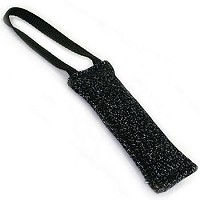
Synthetic fabric puppy tug by Leerburg Online
With smaller/younger pups, you can play Tug with a soft braided rope, a hand towel tied to a short rope (you hold onto the rope as a handle), or even a knotted pair of socks.
But for larger or older dogs, I recommend a sturdier commercial Tug toy. Leerburg Online sells great Tug toys for puppies and adult dogs.
I repeat: tug toys are NOT chew toys. They should never be left down for the pup to chew on. Tug toys are for interactive play with YOU. After the play session, put the tug toy up on a shelf.
Where to play Tug
Tug is an energetic game, so it really should be played outdoors. Remember, you want your pup to be calm indoors.
But if you have a basement or game room, you might decide to designate that space for active games such as Tug or Fetch. If you're consistent, your dog will learn that this is the fun room, but that he needs to be calm in the rest of the house.
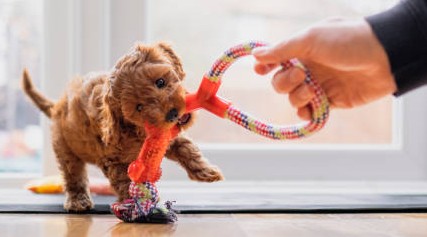
Your pup's first Tug game
If you're in a smallish area, your pup doesn't need a leash. But if the area is larger and your pup is the kind of explorer who will likely run away from you, a long leash should be attached and dragging so you can control his behavior as needed.
Don't give him the chance to run off with the Tug toy. You want him to learn good habits, not bad ones.
When you bring out the Tug toy, show it to your dog and name it: "Tug. Tug Tug. Play Tug?" Keep your voice upbeat and encouraging. Appeal to your dog's prey instinct by twitching the Tug along the ground like an agile, quick-moving prey animal like a chipmunk.
First the Tug is still. Then it does a quick, wiggly movement. Then it freezes again. Then suddenly leaps to one side. Make it interesting!
If your dog grabs hold of the Tug, keep moving it like the prey animal is trying to get away – but not too forcefully! If you rip it away from your dog, he will either become discouraged or he will frantically try to re-grab it and end up accidentally closing his teeth on your hand. Obviously another bad habit not to start.
It takes some practice to learn just how much you should move the Tug to keep your particular pup interested. Every dog is different. Some are persistent and focused, while others are more casual or easily distracted.
Once he is firmly gripping the Tug toy, many dogs don't mind their front feet being lifted off the ground – AFTER they're done teething. But don't lift your dog completely off the ground! You could damage his joints, tendons, ligaments, backbone, or spinal cord.
Similarly, don't whip him vigorously back and forth, else you will damage his neck vertebrae or teeth.
This is a GAME. Keep it playful and encouraging, not competitive or violent.
Let your dog win!
Who should win games of Tug? Traditionally it was thought that you, as the leader, should win. But with this particular game, it's more satisfying if you BOTH win.
Let me explain...
After about 10 seconds of Tugging, step on the end of the leash, let go of the toy, and let your dog parade around you in triumph, carrying his prize.
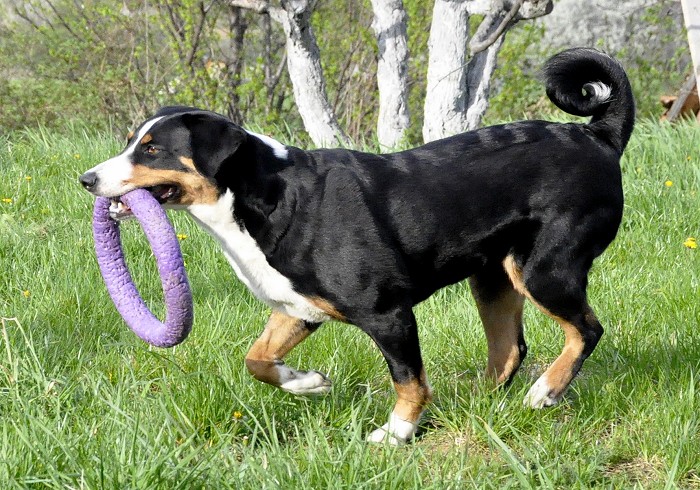
Once he's made a couple of proud circuits around you, use the leash to guide him closer so you can stroke him approvingly along his sides and back while he holds the toy. You want him to feel proud of himself, to think: "Look at me! Aren't I something?" And you want him to connect these great experiences with YOU, his beloved leader.
And yet your dog must learn to let go of the toy.
The one essential rule of Tug games
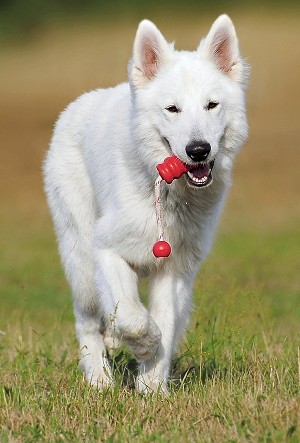
Your pup shouldn't be allowed to play with tug toys by himself. These toys should be reserved for interactive play with YOU.
Although you've let your pup "win" the round so far, there is an essential rule that you must teach him.
He must release the toy when told to.
After the dog has had a minute to parade around with his prize, it's time for you to get the toy back. He must release it so YOU can decide whether to start another round or end the game.
Your pup needs to learn that the only way to play with this particular toy is with YOU. So whenever he "wins" by pulling the Tug toy away from you, the game can only continue if he brings the toy back to you and releases it.
Teaching your pup to give up the Tug toy
Get hold of his dragging leash and bring him close to you. Take hold of the toy and say "Give" or "Drop" or whatever your let-go word is.
Now, understandably your puppy might be reluctant to part with such a wonderful toy. He might even think that since you've put your hand back on the toy, you're starting up the game again. This is natural for a beginner dog to think, so if he starts to tug at the toy again, don't get mad! You don't want to dim his enthusiasm.
Just stand very still and hold your end of the toy very still. Say again, "Give" in a calm voice. Your stillness makes the game much less fun for your pup – he sees that you're refusing to play, so he's more likely to let go.
But if he absolutely won't let go even when you're holding the toy very still, open his mouth so that he must release the toy. In the article on teaching your pup to release or drop an object, you learned two ways to open your pup's mouth.
When you finally have the toy, praise him cheerfully ("Good dog!") and immediately continue the game. Say, "Tug! Play Tug!" and start moving the Tug in that enticing prey animal pattern.
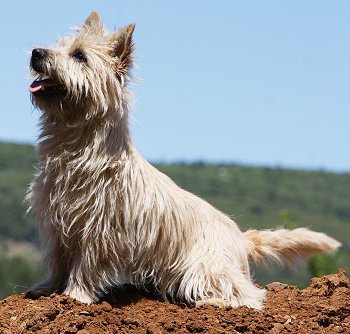
Cairn Terrier waiting eagerly for you to begin the next round of Tug
You want him to learn that giving up the toy doesn't mean the game is over. In fact, giving up the toy is the only way to get you playing again!
In this way, he learns that YOU are a vital part of this game. He can't play it by himself.
Of course, eventually you will need to decide that the game is over. When he releases the toy and you're not going to continue, give him a few tasty treats so as to end things on a happy note.
What to do about growling during Tug games
First, YOU shouldn't growl during Tug games! Yes, some owners do make their own growling or rrr-rrr-rrr sounds when they play Tug.
For some dogs, this is fine, but it's safer if you keep your own sound effects to a minimum. Having their leader growl at them can over-stimulate some pups and intimidate others.
As for your dog's own growling sounds, some pups are just naturally more vocal than others.
However... growling can also be a sign of anxiety. When a dog becomes anxious, he might growl in a blustery attempt to convince you that he's one tough dude who should not be messed with!
You can relieve his anxiety by lowering the intensity of the game. Pull less forcefully. If he stops vocalizing, try slowly building back up again to find out what level works best for him.
Now, if he's growling while refusing to give up the toy, that's a different kettle of fish. Deliver a sharp "AH-ah!" and end that play session.
Similarly, you should stop the game if your dog:
- just gets too crazy
- jumps all over you
- repeatedly grabs at your hand instead of the toy
You might try again on a different day, or you might wait until he's more mature and more settled in his follower status. Or it might turn out that Tug is simply not a good game for this particular pup.
Young children should NOT be allowed to play tug of war with a dog. Young children can't judge when a dog is out of control and they can't correct a dog with enough authority when his behavior goes over the line. This ends up teaching and reinforcing bad habits instead of good.
What if your dog won't play tug?
Not all dogs enjoy playing Tug. Some have very little prey instinct. Some are so gentle and submissive that they're intimidated by the idea of grabbing hold of a toy in your hand and trying to wrest it away from you.
But before you give up, try making the game less intimidating – move the toy farther away from your own hand.
For example, tie the Tug toy onto one end of a 2- or 3-foot cord. Hold the other end of the cord and manipulate it so that the Tug toy bounces around in a (hopefully) enticing way. Your pup might just pounce on it and then the pair of you can play Tug separated by a few feet. Over time, you can gradually work your hands along the cord, closer and closer to the toy.
My best-selling books – now available FREE on my website
 Respect Training For Puppies: 30 seconds to a calm, polite, well-behaved puppy is for puppies 2 to 18 months old. Your puppy will learn the 21 skills that all family dogs need to know. Click here to read for free.
Respect Training For Puppies: 30 seconds to a calm, polite, well-behaved puppy is for puppies 2 to 18 months old. Your puppy will learn the 21 skills that all family dogs need to know. Click here to read for free. Teach Your Dog 100 English Words is a unique Vocabulary and Respect Training Program that will teach your adult dog to listen to you and do what you say. Click here to read for free.
Teach Your Dog 100 English Words is a unique Vocabulary and Respect Training Program that will teach your adult dog to listen to you and do what you say. Click here to read for free. 11 Things You Must Do Right To Keep Your Dog Healthy and Happy helps your dog live a longer, healthier life. Get my honest advice about all 11 Things before you bring home your new puppy, because some mistakes with early health care cannot be undone. Click here to read for free.
11 Things You Must Do Right To Keep Your Dog Healthy and Happy helps your dog live a longer, healthier life. Get my honest advice about all 11 Things before you bring home your new puppy, because some mistakes with early health care cannot be undone. Click here to read for free.
